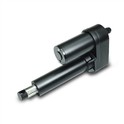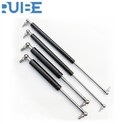As a seasoned supplier of gas dampers, I understand the critical role that proper alignment plays during the installation process. Gas dampers are essential components in various applications, from automotive systems to cabinetry, providing controlled motion and damping effects. Ensuring the correct alignment of these dampers is crucial for their optimal performance, longevity, and overall safety. In this blog post, I will share some valuable insights and practical tips on how to ensure the proper alignment of a gas damper during installation.
Understanding the Basics of Gas Dampers
Before delving into the installation process, it's important to have a clear understanding of what gas dampers are and how they work. Gas dampers, also known as gas springs or gas struts, are mechanical devices that use compressed gas to provide a controlled force. They consist of a cylinder filled with gas, typically nitrogen, and a piston rod that moves in and out of the cylinder. When the piston rod is compressed, the gas inside the cylinder is compressed, creating a force that resists the compression. This force is used to provide damping, support, or counterbalance in various applications.


Gas dampers are commonly used in automotive applications, such as hoods, trunks, and doors, to provide smooth and controlled opening and closing motions. They are also widely used in cabinetry, furniture, and industrial equipment to provide soft closing and opening functions. In each application, the proper alignment of the gas damper is essential to ensure its optimal performance.
Pre-Installation Preparation
The first step in ensuring the proper alignment of a gas damper is to prepare the installation site. This involves carefully examining the application and identifying the correct mounting points for the damper. Here are some key steps to follow:
- Review the Installation Instructions: Before starting the installation process, carefully review the manufacturer's installation instructions for the specific gas damper you are using. These instructions will provide detailed information on the correct mounting points, torque specifications, and any other important considerations.
- Inspect the Mounting Points: Check the mounting points on the application to ensure they are clean, free of debris, and in good condition. Any damage or irregularities in the mounting points can affect the alignment of the gas damper and lead to premature failure.
- Measure the Mounting Points: Use a measuring tape or caliper to accurately measure the distance between the mounting points. This will help you select the correct length and size of the gas damper for your application.
- Select the Correct Gas Damper: Based on your measurements and the requirements of your application, select the appropriate gas damper from our wide range of products. We offer a variety of gas dampers, including Gas Damper for Car and Cabinet Gas Damper, to meet the needs of different applications.
Installation Process
Once you have prepared the installation site and selected the correct gas damper, it's time to start the installation process. Here are some key steps to follow:
- Mount the Gas Damper: Begin by mounting one end of the gas damper to the application using the appropriate mounting hardware. Make sure the damper is securely attached and aligned with the mounting point.
- Align the Other End: Carefully align the other end of the gas damper with the corresponding mounting point on the application. Use a level or straightedge to ensure the damper is perfectly horizontal or vertical, depending on the requirements of your application.
- Secure the Gas Damper: Once the gas damper is aligned, use the appropriate mounting hardware to secure the other end of the damper to the application. Make sure the damper is tightened to the recommended torque specifications to prevent any movement or loosening during operation.
- Test the Alignment: After the gas damper is installed, test the alignment by operating the application. Check for smooth and controlled motion, and make sure the damper is providing the desired damping effect. If you notice any issues with the alignment or performance, make the necessary adjustments.
Troubleshooting Common Alignment Issues
Even with careful preparation and installation, alignment issues can sometimes occur. Here are some common alignment issues and how to troubleshoot them:
- Uneven Movement: If the gas damper is not providing smooth and even movement, it may be misaligned. Check the mounting points and make sure the damper is properly aligned. You may also need to adjust the length or angle of the damper to achieve the desired performance.
- Excessive Noise or Vibration: Excessive noise or vibration during operation can indicate a misaligned gas damper. Check the mounting points and make sure the damper is securely attached. You may also need to lubricate the damper to reduce friction and noise.
- Premature Failure: If the gas damper fails prematurely, it may be due to improper alignment. Check the installation process and make sure the damper was installed correctly. You may also need to replace the damper with a new one to ensure optimal performance.
Importance of Proper Alignment
Proper alignment of a gas damper is essential for several reasons:
- Optimal Performance: When a gas damper is properly aligned, it can provide smooth and controlled motion, ensuring the optimal performance of the application. This can improve the user experience and reduce the risk of damage to the application.
- Longevity: Correct alignment helps to reduce stress and wear on the gas damper, extending its lifespan. This can save you money in the long run by reducing the need for frequent replacements.
- Safety: A misaligned gas damper can pose a safety risk, especially in applications where it is used to support heavy loads or provide critical functions. Proper alignment ensures the safe operation of the application and reduces the risk of accidents.
Conclusion
Ensuring the proper alignment of a gas damper during installation is crucial for its optimal performance, longevity, and safety. By following the steps outlined in this blog post, you can ensure that your gas damper is installed correctly and provides the desired damping effect. If you have any questions or need further assistance with gas damper installation or alignment, please feel free to contact us. We are a leading supplier of gas dampers, and our team of experts is always ready to help you find the right solution for your application. Whether you need a Gas Damper for Car or a Cabinet Gas Damper, we have the products and expertise to meet your needs. Contact us today to discuss your requirements and start the procurement process.
References
- Manufacturer's installation instructions for gas dampers
- Industry standards and best practices for gas damper installation
- Technical literature on gas damper design and operation






